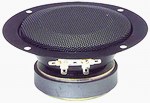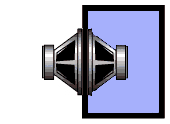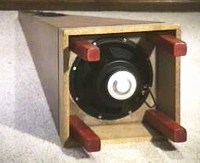Speakers
Since the speakers were part of a kit, I did not get a chance to select them but I did get to decide how to use them.
Tweeters

The tweeters are a low cost exponential horn unit made by Motorola. The horn is 3" square at the exit. The actual driver element is about an inch diameter and attached to a small paper cone at the throat of the horn. Because this is a piezo unit, it does not absolutely need a crossover making it easy to use. There does seem to be some ringing or harshness from these tweeters. They may need to be some dampening or padding down.
I wanted to experiment with tweeter use. I tried implement an idea from the Bose 901 series louspeakers. I placed one of the tweeters on the front of the enclosure wired normally. I placed the other on the rear of the enclosure wired with reverse polarity. This is known as a dipole configuration. The purpose was to spread some of the high frequency energy around the listening environment to create a fuller sound (more room reflections). In the end, this may not have actually been a good idea, but it doesn't seem to hurt.
Midranges

The midrange was meant to be installed into the same chamber as the subwoofer in the car audio case. Therefore, it is a sealed back midrange with a fixed cover. Two midrange speakers were installed, one over the other on the face of the pyramid under the tweeters. The combination of two 5" drivers is approximately equal to one 7" driver but without the penalty of larger mass and more cone motion. I argued at the time that this would decrease the required excursion of the driver and reduce distortion.
Unfortunately the actual midrange performance is poor. The sealed back driver, with its accordian style paper suspension, is just not up to the task of high fidelity midrange reproduction. But they work and they don't sound bad.
Subwoofers
Each kit included two 12" MTX generic subwoofers. Without Theil/Small parameters, I designed the chamber size based on volume specified with the speaker kit. I had wanted to use a sealed box, specifically an acoustic suspension (AS). In a AS loudspeaker, the sealed air mass within the chamber acts like a spring and tries to return the speaker cone to its neutral position. The size of the chamber, and therefore the 'springiness' of the air mass is matched to the complience of the driver. Compared to other loudspeaker arrangments like bass reflex (vented), the AS is less efficient and converting electrical energy to sound. But in general it has better frequency response and the spring effect can protect the speaker from damage under some operating conditions.

Each channel then has two 12" subwoofers, each needed a specific volume of air in the chamber. I used a technique known as Isobaric configuration. Isobaric means equal pressure and in this case it refers to the pressure between the two cones. In Isobaric configuration, two speakers are mounted together to create three pressure regions. They are stacked in such a way that there is a volume of air between the two speakers that stays at normal pressure. One speaker sees the outside world, and one speaker sees the A.S. chamber. Take a look at the graphic to see what this means. Since I have stacked the speakers so they face each other (like a clam shell), the outside speaker needs to be wired with reverse polarity. The sound is emitted from the back face of the outer speaker into the room, but that doesn't matter sonically for subwoofers.
Because each subwoofer sees essentially only half the air load as in normal configuration, it only needs half the volume as one would normally require, allowing the final chamber size to be much smaller than the non-isobaric configuration. Theoretically this can also mitigate some non-linearities. Of course this doesn't come for free. The inner driver is sealed in a small chamber and has much poorer thermal dissipation than the outer driver. This can lead to power compression and increased distortion (as the speaker pair goes non-isobaric). The vertical mounting scheme reduces vibration of the enclosure, but can be detrimental over the long term to the speaker by causing sagging suspension.
